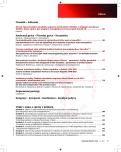Activity of Blood Transfusion Service in the Czech Republic 1989–2013
Authors:
P. Turek 1; J. Masopust 2
Authors‘ workplace:
Transfuzní oddělení Thomayerovy nemocnice, Praha-Krč
1; Transfuzní oddělení, Krajská zdravotní – Masarykova nemocnice v Ústí nad Labem
2
Published in:
Transfuze Hematol. dnes,20, 2014, No. 4, p. 125-135.
Category:
Comprehensive Reports, Original Papers, Case Reports
Overview
Blood transfusion service (BTS) in the Czech Republic is provided by two types of institutions, different in principal. Majority of blood establishments (BE) who collect blood and process blood into blood components works as a department of a hospital or it is indirectly linked with a hospital. Blood banks who supply hospitals with blood components are either a part of “blood establishment”, either they run their services in bigger hospitals without blood establishment (often merged with haematology and/or biochemistry). Number of facilities collecting blood is not changing over the years, but increasing number of these “collecting centres” send collected blood to be processed and tested in bigger centre. Second part of Blood transfusion service consists of independent plasmapheretic centres which produce exclusively plasma for fractionation, these centres extend their services especially after 2008. Blood and blood components are collected nearly exclusively from voluntary, non-remunerated donors, plasmacentres usually compensate their donors for time and inconvenience. Donor population is stable and relatively safe, but registry of donors giving whole blood is slowly growing smaller. Both prevalence and incidence of infectious disease markers are low and remarkable lower in “hospital based” BTS compared to donors of plasmapheretic centres (especially for hepatitis C). Moreover prevalence/incidence of infections, excepting HIV, among blood donors are decreasing. Production of blood components is stable over the years, country is self-sufficient in blood components: circa 40 red blood cell units per 1000 inhabitants; spectrum of products shifted from whole blood and red cells resuspended in plasma to buffy-coat free packed red cells in additive solutions either leucodepleted products. Predeposit autologous programme is popular. Circa 3.2 therapeutic doses of platelets per 1000 inhabitants are available and the production is continuously increasing, nearly 80 % platelets are produced by apheresis. Consumption of plasma for clinical purposes (6 months quarantine) has increased in late 90-ties and still remains higher than in Western countries. Over 550 tons of plasma is sent for industrial fractionation in the last years – well enough to cover needs of plasma derived proteins. Transfusion policy differs in different hospitals even though several recommendations based on expert opinion are available for clinical use of blood. Severe adverse effects of transfusion are relatively rare.
Key words:
Czech Republic, Blood Transfusion Service, blood components, production, consumption, adverse reactions to transfusion
Sources
1. Činnost zdravotnických zařízení v oboru transfuzní služby v České republice v roce 2013, Aktuální informace UZIS, 39, 2013, www.uzis.cz.
2. Zpráva o činnosti zařízení transfuzní služby za rok 2013, www.mzcr.cz.
3. Turek, P. Produkce a spotřeba transfuzních přípravků v České republice v r. 2006, Trans Hematol dnes 2007; 3: 159-163.
4. Turek, P. Činnost nemocniční transfuzní služby v České republice v roce 2009, Trans Hematol dnes 2010; 3: 177-179.
5. Turek, P. Přehled produkce transfuzní služby ČR za rok 2011. Trans Hematol dnes 2012; 3: 144.
6. Masopust, J. Autotransfuze v České republice v roce 2011. Trans Hematol dnes 2012; 3: 145-148.
7. Turek, P. Přehled produkce transfuzní služby ČR za rok 2013. Trans Hematol dnes 2014; 2: 92-93.
8. The Collection, Testing and Use of Blood and Blood Components in Europe. 2008 Report, EDQM, Council of Europe, www.edqm.eu/en/blood-transfusion-reports-70.html.
9. Metodika zajištění odběru a distribuce transfuzních přípravků a krevních derivátů, Věstník MZČR, č. 3/2007.
10. Cochrane Injuries Group Albumin Reviewers: Human albumin administration in critically ill patients: systematic review of randomised controlled trials. BMJ 1998; 317: 235-240.
Labels
Haematology Internal medicine Clinical oncologyArticle was published in
Transfusion and Haematology Today

2014 Issue 4
Most read in this issue
- The significance of heavy/light chain immunoglobulin pairs (Hevylite™) in multiple myeloma
- Retransfusion system with integrated double filtration – parameters of product quality
- Activity of Blood Transfusion Service in the Czech Republic 1989–2013
- Pharmacokinetics as a tool for optimising the treatment of patients with haemophilia
